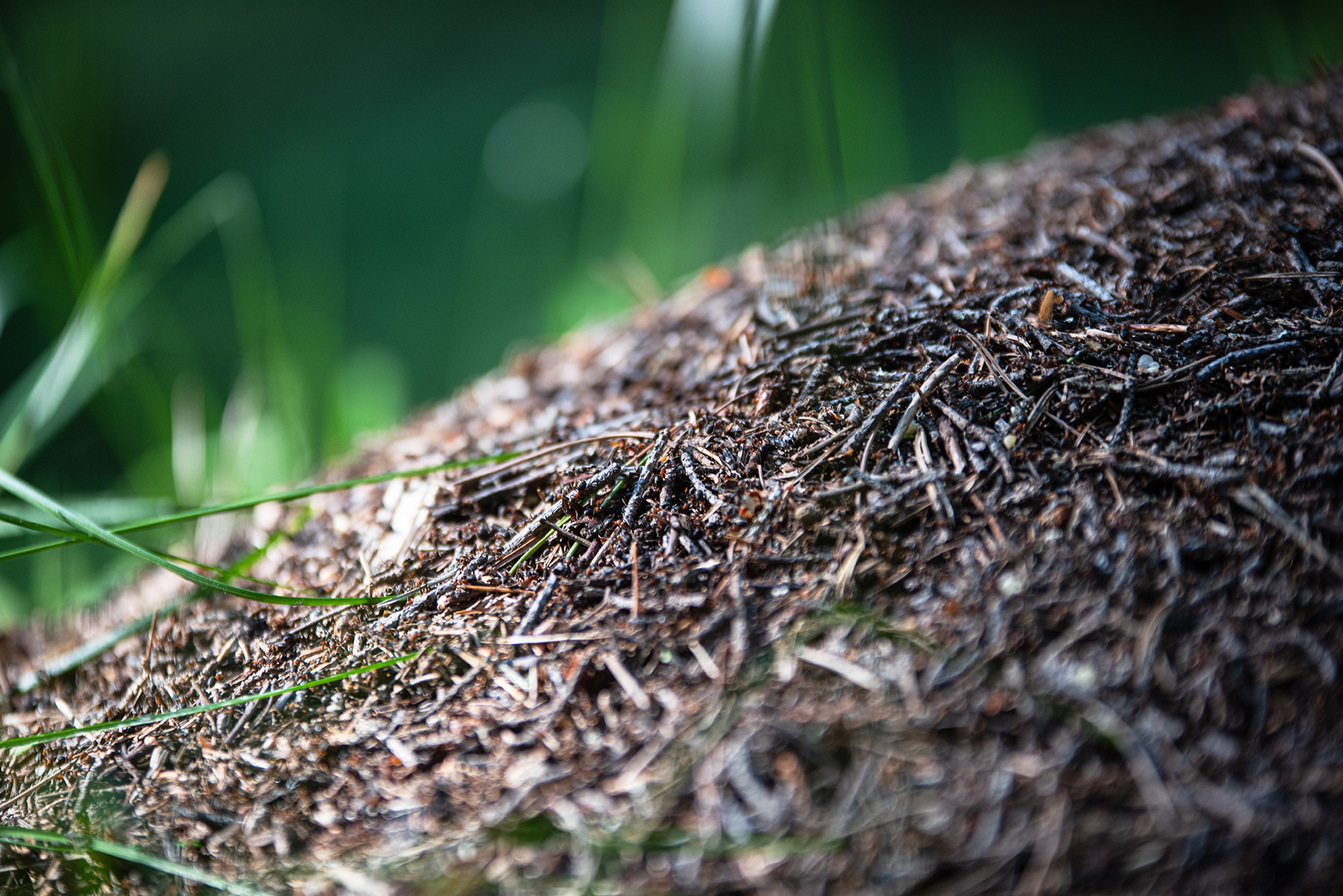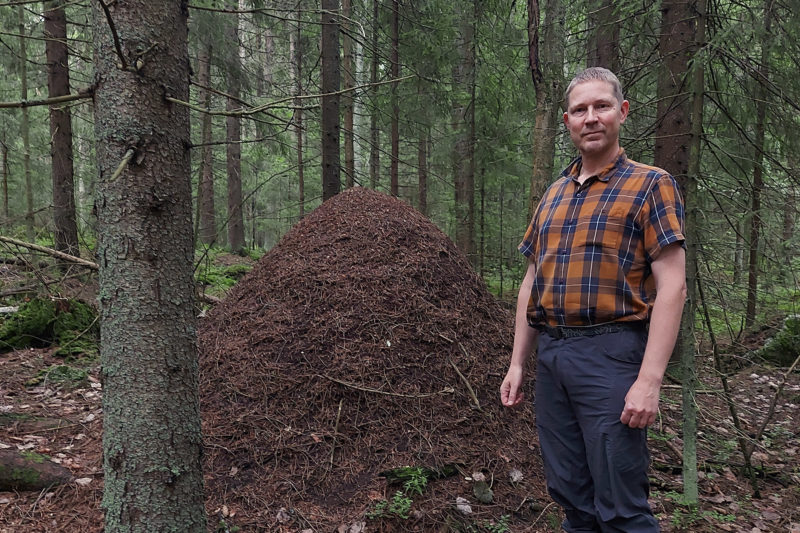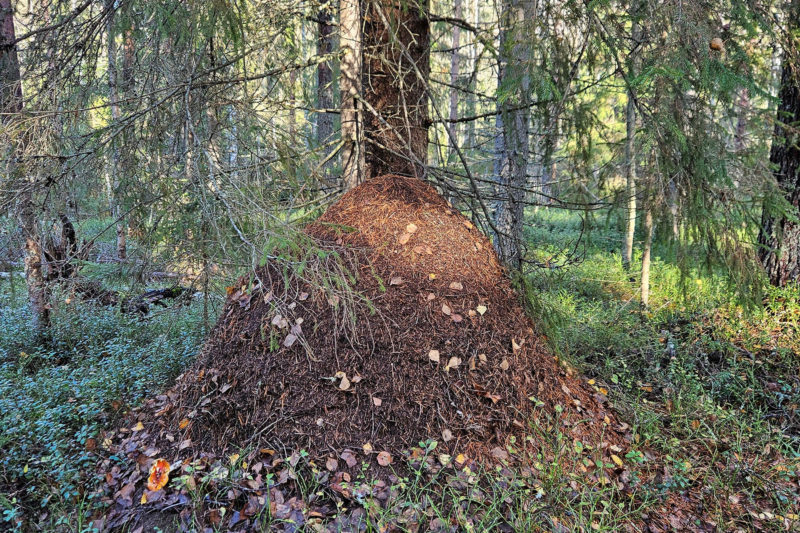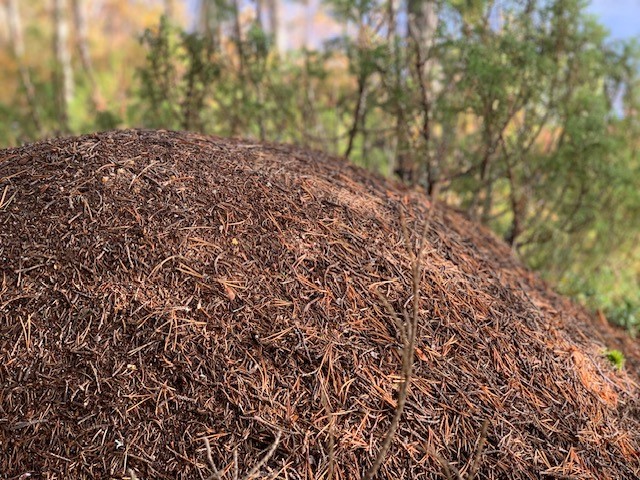
Mound ants increase biodiversity and carbon sinks in forests and are harmful to pests, says researcher Jouni Sorvari at Natural Resources Institute Finland.
Anyone who has spent any time outdoors is probably familiar with mound ants, also known in English as wood, thatching or field ants. They can prevent insect damage in forests.
’Recent research indicates that in some way, mound ants reduce the damage by European spruce bark beetle. We just haven’t figured out the mechanism yet,’ says Jouni Sorvari, researcher in the Kekometsä [Anthill Forest] project at Natural Resources Institute Finland (Luke).
Mound ants, less than one centimetre long, mainly live in coniferous forests. There are a total of six species in Europe, five of which are found in Finland.
The European spruce bark beetle is about five millimetres long and dark brown in colour. Together with other insect pests, it has become a significant threat to forests, forest nature and forest carbon sinks.

’There also exist some older studies on the benefits of mound ants in combating insect damage in birches,’ Sorvari notes.
According to the Finnish Forest Centre, over 6,000 hectares of forest were felled in Finland last year because of insect damage. With global warming, it is expected that the damage will increase and also begin to occur further north.
The volume of fellings necessitated because of insect damage has been on the increase. In Germany and the Czech Republic, the spruce bark beetle has killed vast areas of forest in recent years and caused havoc in the timber market. The infestations have been favoured by periods of drought and long spells of hot weather.
Read more: Natural enemies may prevent damage by spruce bark beetle – researcher explains how
Ants are useful for forest nature
Mound ants are a part of forest nature and their presence keeps the forest healthier. They improve biodiversity, resistance to insects, and carbon sinks.
The Kekometsä project, which Sorvari works in, studies the effect of retention tree groups of different sizes and compositions on the survival of mound ants and other forest species linked to them. Another task is to identify the types of commercial forests that are most likely to contain mound ants.
In this way, it will be easier to take them into account during fellings. Some of the things studied are the extent of canopy cover, the total basal area of trees and the range of species, all of which affect the occurrence of mound ant colonies.

The hypothesis is that retention tree groups and protective thickets may help anthills to survive fellings. However, the topic has not been studied before. The study is carried out in Finland and, to some extent, in Sweden, and the results will be applicable across Europe.
Sorvari suggests it is useful to take a look at the trees near an anthill.
’Often the trees near an anthill are stouter than others further off,’ he says.
The stoutness is due to the fact that ants typically ferry conifer needles and twigs into their mounds. As they decay, their nutrients become easier to absorb by trees and other plants.
Anthills are carbon storages
Jouni Sorvari points out that anthills also function as carbon storages in the forest.
’The amounts are smaller than those stored in trees, but large mounds can store a surprising amount of carbon. One large mound can contain over 20 cubic metres of organic material.’
The amounts are smaller than those stored in trees, but large mounds can store a surprising amount of carbon. One large mound can contain over 20 cubic metres of organic material.
Sorvari explains that normally, most of the mound is above ground, but ants can tunnel down to a depth of half a metre.
’On dry and sandy soils with plenty of light, the mounds can be lower, but their underground parts are sometimes as large as the visible mound,’ Sorvari says.
The biomass heaped in the mounds decays more slowly than the needles and litter that fall evenly on the ground. In well-maintained mounds, about 50–80 percent of the material is drier than the surrounding soil. They contain less fungal biomass and decomposer organisms, which is why the mounds function as carbon binders.
Mounds on open felling sites are abandoned
According to Sorvari, when a mound is abandoned because of felling or another reason, it will decay fairly quickly. When this happens, the carbon stored in the anthill is released into the atmosphere.
’As a rule, if the trees surrounding a mound are felled, it will be abandoned within a few years. Normally, by the time a stand is ripe for the first thinning, all mounds except those found on the edges of more mature stands will have been abandoned and have decayed,’ says Sorvari.

Forest fellings do not cause a mass death of mound ants, but generally the mounds left in open terrain become uninhabitable, since the nourishment provided by trees must be fetched from further afar. The temperature or moisture of the nest can also become less than optimal.
’A large part of the dry interior of the nest has a temperature of almost +30 degrees Centigrade, which is optimal for reproduction. After the felling, the microclimate of the nest changes, and the temperature regulation no longer functions,’ Sorvari explains.
Groups of retention trees give shade
According to Jouni Sorvari, mound ants are most likely to survive fellings when trees, and particularly spruces, are left close to the mounds. Birches and pines, as well as oaks in the more southern parts, are a good complement. Earlier studies have shown that a change in the microclimate is harmful to the mounds.
’Large mounds easily become too dry because of sun and wind. That’s why, in this study, we aim to place the retention tree groups so that they give shade to the southern aspect of the mound in particular.’
Depending on the species, mound ant colonies may inhabit one or more nests.
Large mounds easily become too dry because of sun and wind. That’s why, in this study, we aim to place the retention tree groups so that they give shade to the southern aspect of the mound in particular.
’Species that only have one nest are mostly found on the edges of stands or spots with plenty of light inside the forest. Species with multiple nests build bigger mounds. They can also live in shadier areas inside the forest, for their large mounds generate enough heat to make them less dependent on direct sunlight,’ Sorvari says.
Species that build multiple nests also like to make new ones on the edges of forest or next to a logging road.
Nests do not thrive in open terrain
In the conifer-dominated forests in Finland the average number of anthills is three to four per hectare. Larger ones are located inside the forest where there is plenty of nourishment, such as insects, dead animals, seeds and especially the honeydew secreted by aphids.
Shortage of food affects ants even when less than fatal. Sorvari says that worker ants found on felling sites are usually smaller, and the production of new queens and males will cease.
’A surprising research result was that wintertime mortality among mound ants living on felling sites is higher than that of ants inside forests.’
Anthills are home to dozens of species
Sorvari explains that mound ants support the diversity of species in commercial forests.
’The mound ant nests are home to dozens of insect and spider species that must find a mound ant nest to live in at some stage of their lives. Also, many more species live in the nests that are not directly dependent on the mound, but which are found there nevertheless,’ Sorvari says.
We may not think about this at all, but in fact, seeing the anthills in the forest makes for a fuller experience. A forest is much more than just trees, berries and mushrooms.
Mound ants have an impact on the range of species in their vicinity, and so they improve the biodiversity of forests.
’Without mound ants, the range of species in forests would be narrower,’ Sorvari says.
The nests may be several decades old.
’Mounds built during the Second World War are still in existence and inhabited in Finland. Sometimes they can be abandoned for a number of years and then taken into use again,’ Sorvari says.
Sorvari goes on to mention the intrinsic value and aesthetic significance of the anthills.
’We may not think about this at all, but in fact, seeing the anthills in the forest makes for a fuller experience. A forest is much more than just trees, berries and mushrooms.’
- Mound ants are insects belonging to the Hymenoptera order. About 5–9 millimetres long, they mainly live in coniferous forests.
- These ants form colonies that live in mounds built of conifer needles and broken twigs. The mounds can reach a height of over one metre, sometimes even two metres. The best places to look for mounds are spots with plenty of light, on the south side of a tree or a stump.
- The nests of mound ants may house hundreds of other forest organisms, both microbes, insects and plants. As part of the forest ecosystem, mound ants manipulate the soil and recycle nutrients.
- Ants are eaten by bears and woodpeckers, among others.
